How to Store Wood Pellets Properly: Tips for Clean Burns and Long-Term Use
The snow’s melted. The birds are singing. It’s finally warm enough to shut down the pellet stove for the season.
But if you’re like most homeowners, you probably still have a few bags of pellets sitting around. Don’t just stack them in a corner and forget about them. Wood pellets are picky when it comes to storage. A little moisture can ruin a whole batch. And bad pellets? They’ll gum up your stove and burn poorly, or not at all. Either way, you’re virtually tossing money into the furnace.
The good news? Storing your pellets properly is easy once you know what to do.
At Terrascape Supply, we don’t want your pellets to go to waste, so we’ve written this blog to educate you on the finer points of storing your wood pellets. Whether you’re keeping them for a few weeks or several months, indoors or out, these tips will keep your fuel in great shape, ready to heat your home immediately.
Ready? Let’s light a fire under this!
Heating Pellets vs Smoker Pellets
Pellet stoves use pellets made of compressed wood or biomass to generate heat. Unlike traditional wood stoves, pellet stoves operate more like a modern furnace, with automatic fuel hoppers and thermostats for controlling heat output and burn rate.
Heating pellets are, at a minimum, made from compressed wood byproducts, such as sawdust and wood chips. Quality heating pellets on the other hand, such as EcoBlaze pellets sold at Terrascape, are made of 100% hardwood sawdust, burn cleaner, producing less ash, leading to reduced maintenance, more heat output, and a warmer home.
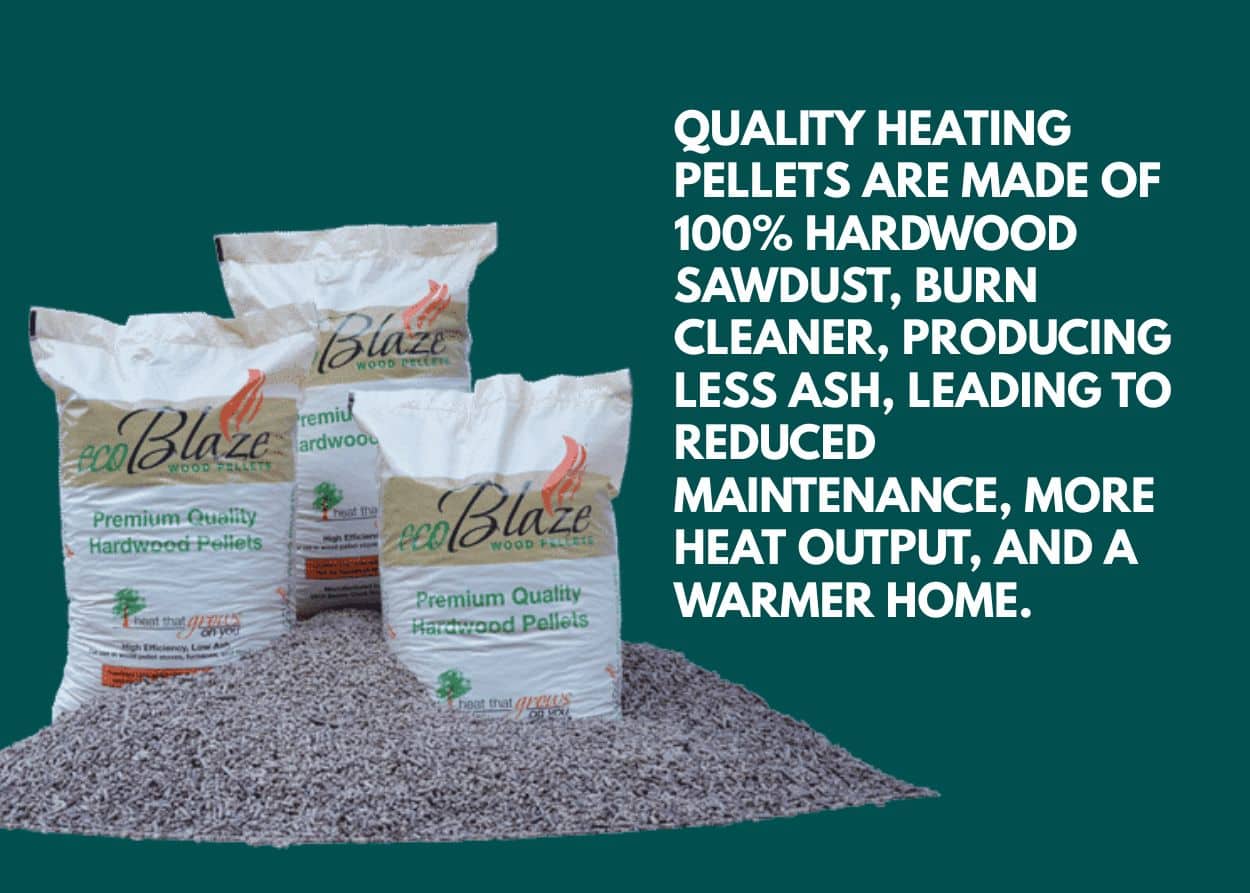
Heating pellets may look like those used for smoking meat, but we don't recommend using them for cooking!! Typical food-grade heating pellets are made from 100% hardwood and do not contain fillers, binders, or additives.
Knowing what both kinds of pellets are made of, there’s one thing they have in common—they have to be kept very dry.
Why Proper Storage Matters
Because wood pellets are made from compressed sawdust, they burn clean, hot, and efficiently—but only if they stay dry. Think of them like a sponge. As soon as they get exposed to moisture, they start to break down and lose their function. If you use a pellet smoker, the basics of storing heating pellets are the same.
Here’s what can happen when pellets go bad:
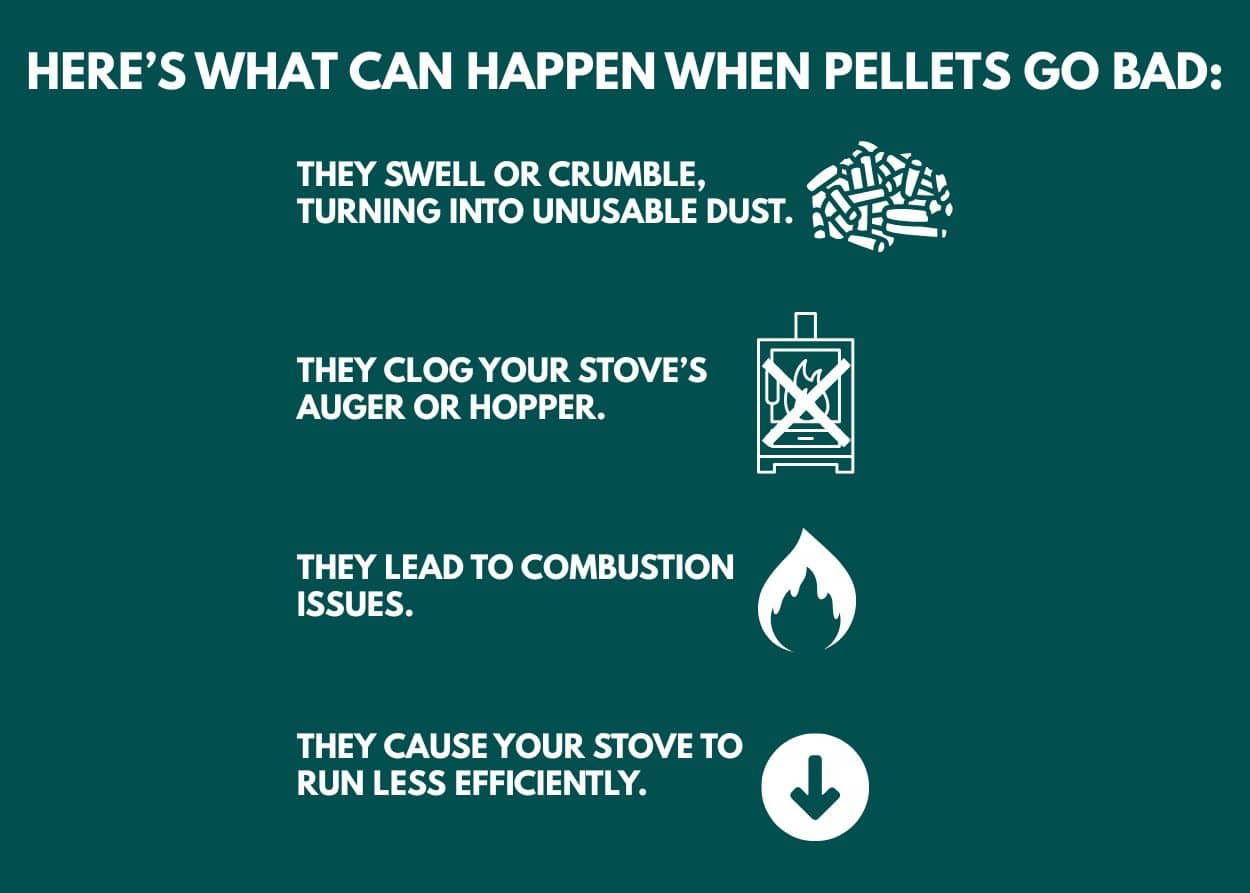
- They swell or crumble, turning into unusable dust. Worse, they could get moldy, leading to a whole host of problems affecting your health and home.
- They clog your stove’s auger or hopper, so you’ll have to clean that out if you ever want that stove to work again. Wet pellets turn into a wood slurry, so it’s not just inconvenient; you’ll likely have to clean the hopper thoroughly. It’s a complex procedure that may require calling in the pros.
- They lead to combustion issues, creating extra ash, soot, and creosote buildup. It’s bad for air quality and a potential fire hazard. By the nature of their efficiency, pellet stoves create less creosote than a conventional wood fireplace or stove, provided the pellets are completely dry and intact.
- They cause your stove to run less efficiently. You’ll likely be unable to reach peak heating efficiency, especially if you keep using those bad pellets, so more fuel will be needed, compounding the other issues mentioned earlier.
Proper storage of heating pellets protects your investment and keeps your heating system working safely and smoothly.
The Best Places to Store Wood Pellets
Indoor Storage (The Gold Standard)
Whenever possible, keep your pellets indoors in a clean, dry spot like:
- A basement with a dehumidifier. Store in a dark and cool place, as the labels on some packages say.
- A utility or laundry room—Though it may sound obvious, heat can damage wood pellets by causing them to ignite, swell, and potentially break down, so avoid storing them by the dryer.
- An attached garage—you can store your pellets in a dry, insulated garage, but keep the bags off the ground to prevent moisture from seeping into the bags. If you must place the pellets on the ground, put them in an airtight plastic bin.
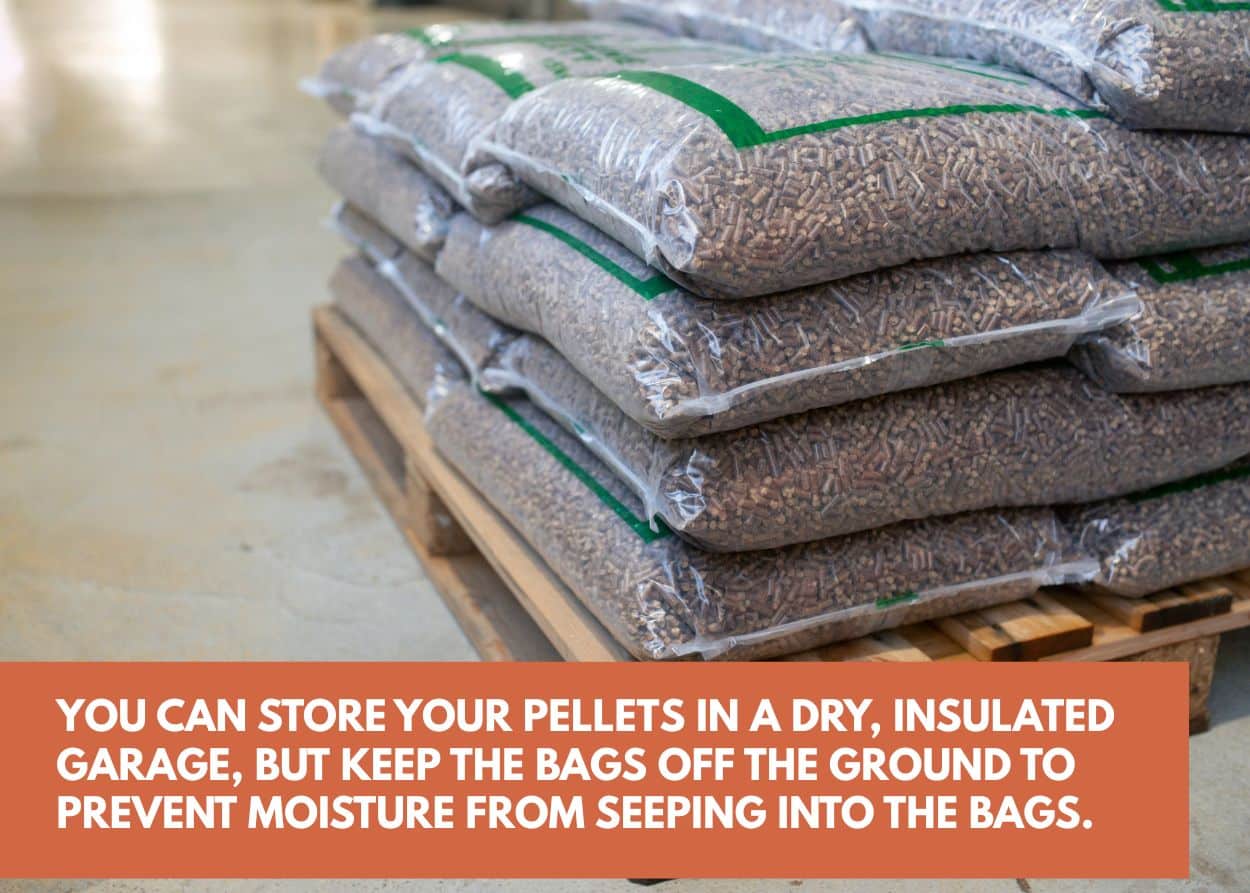
- In a spare closet, if you don’t mind sacrificing the space.
When you store your heating pellets indoors, they get total protection from rain, snow, and temperature fluctuation, and less exposure to pests or rodents. Conveniently, they’re also easier to monitor and access when needed.
Just make sure the area stays dry year-round. Avoid areas with plumbing leaks or where water might pool during a storm.
Outdoor Storage (With the Right Prep)
What if you don’t have room inside? You can store pellets outside—but you need to be smart about it:
- It’s even more critical to use pallets or shelving to keep the bag of pellets off the ground, as moisture from grass, gravel, or earth will quickly absorb into the bags to ruin the pellets.
- Cover stacks with a tarp or waterproof cover. The UV radiation from sunlight can degrade the plastic bags and protective coverings, with the potential of moisture penetration and damage to the pellets. A silver colored tarp can help reflect UV light and reduce heat buildup under the tarp.
- Choose a sheltered spot under a porch, lean-to, or carport. Ensure rain runoff from your roof doesn’t land on your bags.
Remember that setting pellets directly on concrete, dirt, or gravel is not recommended. Moisture can wick up through the bottom of the bag, even if it doesn’t look wet. Like that bag of deicing salt you forgot about until a strange pool of liquid formed around it, wood fuel pellets are hygroscopic, meaning they readily absorb moisture from the surrounding environment. Whether you’re storing your pellets indoors or outdoors, the best way to store them is in an airtight container.
If you live in a high-humidity area, double-layer protection is even better. Think: tarp plus an airtight bin.
How to Keep Pellets Dry and Pest-Free
Even unopened bags aren’t invincible. A small tear or hole can let in enough moisture or mice to ruin things quickly.
Here are a few things to protect your pellets further:
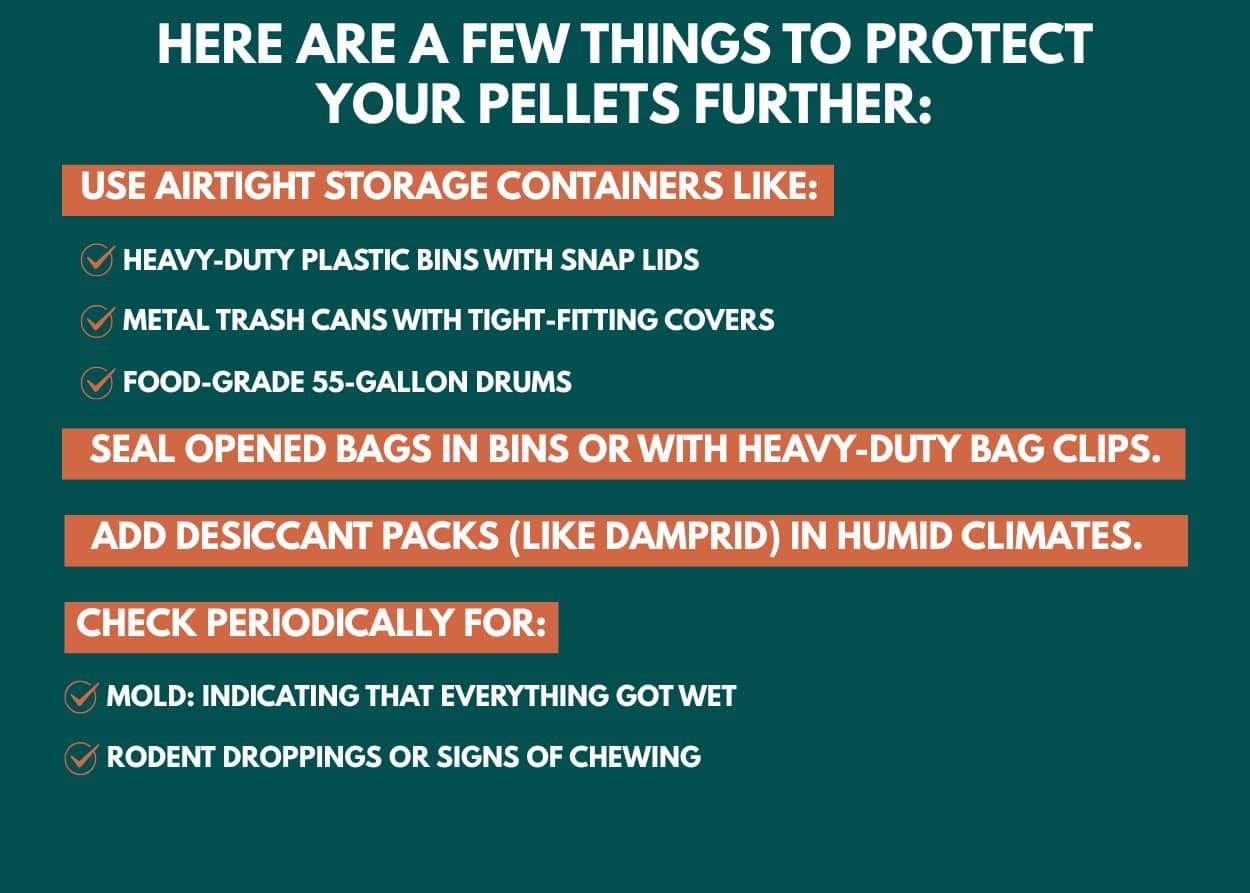
- Use airtight storage containers like:
- Heavy-duty plastic bins with snap lids
- Metal trash cans with tight-fitting covers
- Food-grade 55-gallon drums
- Heavy-duty plastic bins with snap lids
- Seal opened bags in bins or with heavy-duty bag clips.
- Add desiccant packs (like DampRid) in humid climates.
- Check periodically for:
- Mold: indicating that everything got wet. Unfortunately, you’ll have to discard the pellets (Carefully, so that you don’t accidentally spread the mold spores or inhale them).
- Rodent droppings or signs of chewing: Dry, wood pellets make for excellent bedding. Do not burn these pellets, even if they’re dry! Burning the pellets can release toxins into the air, like Hantavirus, a deadly disease.
If your area is known for critters, go with metal containers. Mice can chew through plastic like it’s nothing.
Recommended Storage Containers
Need ideas for what to actually use? Here are a few homeowner-friendly options that work well:
- Rubbermaid-style totes (20-40 gallons)
Pros: They’re cheap, easy to find, and stackable. Any big box store will stock them.
Cons: Not all plastic totes are made alike. Some have better seals than others, but you can modify them to be airtight. Don’t forget that rodents can chew through plastic, too.
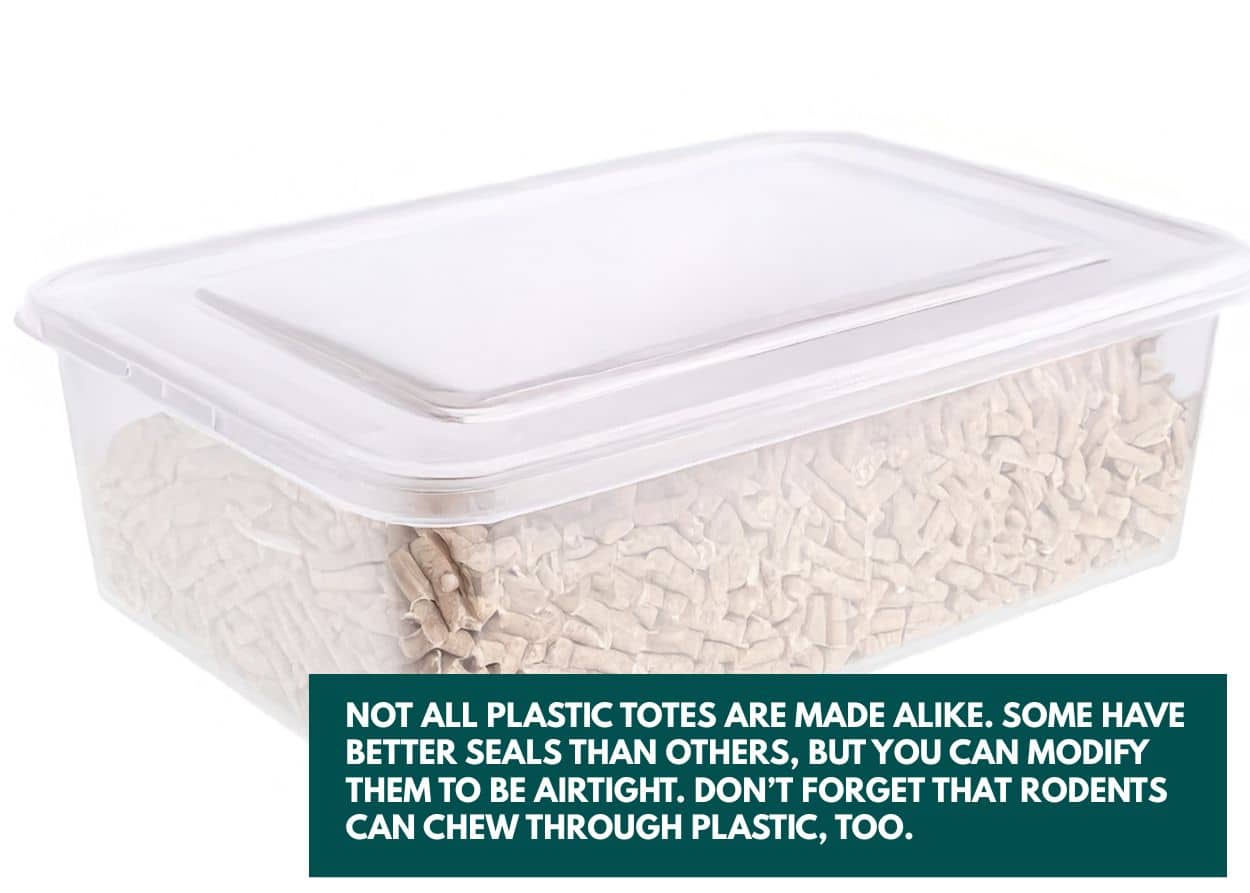
- Metal garbage cans with lids
Pros: The classic option, metal garbage cans are durable and rodent-proof.
Cons: They’re heavy when full.
- 55-gallon plastic or metal drums
Pros: They’re excellent for bulk storage, reusable, and can be sealed for long-term storage.
Cons: They’re bulky and hard to move once they’re full, and take up a lot of space. The pellets will absorb any chemical residue in them, so it’s best to use new barrels. Once again, plastic drums should be avoided if rodents are a concern.
- Custom-built wooden storage bins
Pros: It can be sized for your space and looks tidy in a garage or shed.
Cons: You’ll need to have it sealed well to keep moisture out.
Pro Tip: Label containers with the date you stored the pellets. That way, you can rotate older fuel first.
How to Tell If Your Pellets Have Gone Bad
You’ve stored your pellets, and before long, it’s starting to get cold again. Before you refill your hopper, do a quick check.
Look for:
- Crumbly texture or powdery dust at the bottom of the bag, which means they’re deteriorating.
- Mold growth or pellets that smell off. A musty smell means moisture damage.
- Pellets that are swollen or soft to the touch, which means they have absorbed moisture and are no longer suitable for burning.
- Heavy clumps that won’t break apart easily—dry wood pellets sift and separate easily, similarly to dry rice.
If the pellets are damp, they won’t burn properly. It’s not worth risking your stove or indoor air quality.
My Pellets Went Bad. Now What?
You’ve tried your best, but you still ended up with bad pellets. If they’re starting to crumble and don’t smell musty, you could compost them, or repurpose them for oil cleanup, firestarters, kitty litter, and even mulch.
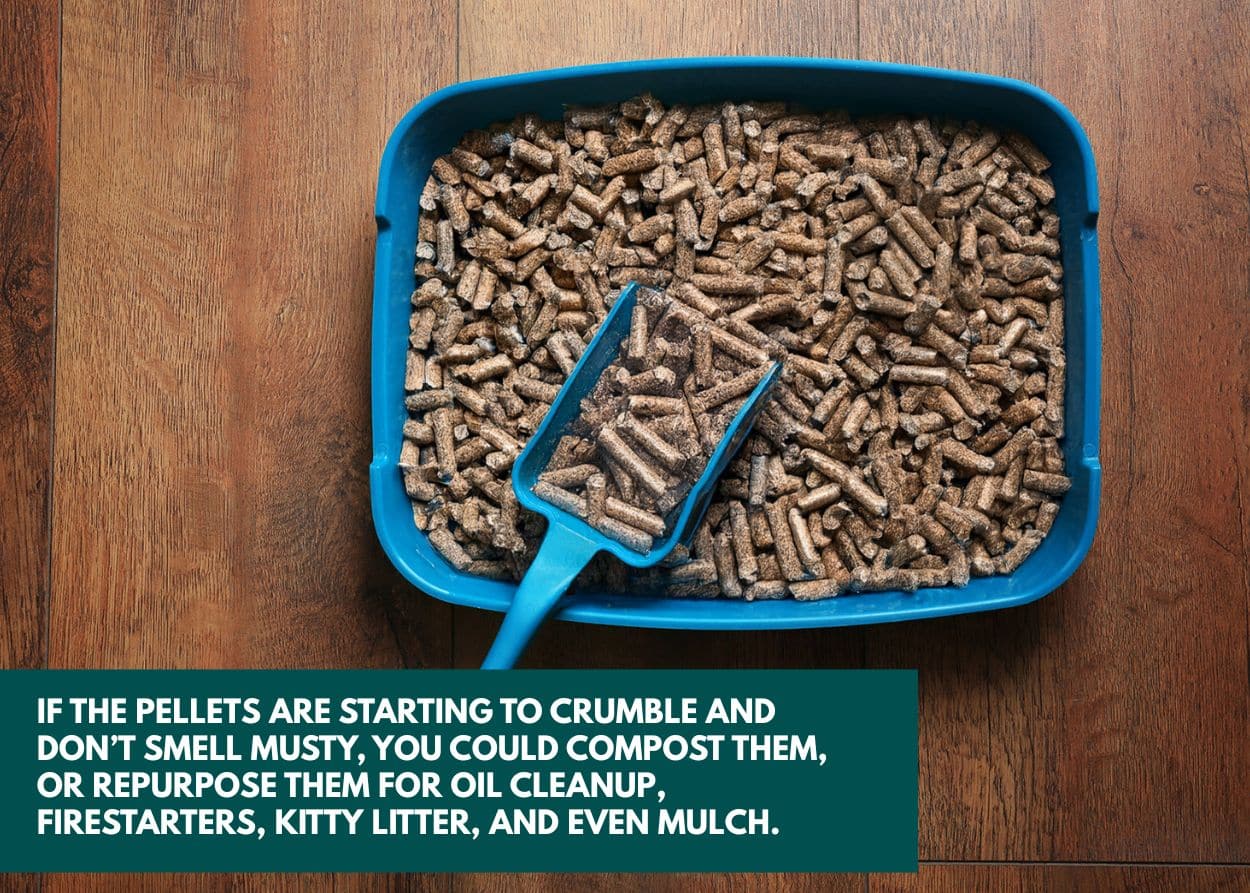
If they’re moldy or pest-infested, into the trash they go.
Bonus Tip: Clean Your Stove Before Storage
Your pellets aren’t the only thing that needs attention. When the season ends:
- Empty the hopper completely (leftover pellets attract moisture)
- Vacuum out ash and dust from the burn pot and ash pan.
- Clean the exhaust vent if needed.
- Inspect gaskets and seals for wear and tear.
A clean stove now means fewer problems in the fall. Don’t be left out in the cold!
Conclusion
Storing wood pellets isn’t complicated—but it is important. Whether tucking them in a basement corner or stashing them under a tarp outside, the key is to keep them dry, off the ground, and sealed up tight.
Do that, and you’ll start next season with high-quality fuel that burns clean, keeps you warm, and saves you money.
At Terrascape Supply, we make it easy to use wood pellets for heating. Whether you’re new to wood pellet heating or you’re an experienced user needing more fuel, we are your source of premium EcoBlaze pellets in Central Pennsylvania—100% hardwood pellets that are locally sourced, manufactured, and competitively priced. Starting at $35 for a ton of pellets delivered, experience the EcoBlaze difference of clean-burning fuel!
Contact us now to learn more about our pellet and delivery prices, and discover the efficient heating you deserve!








